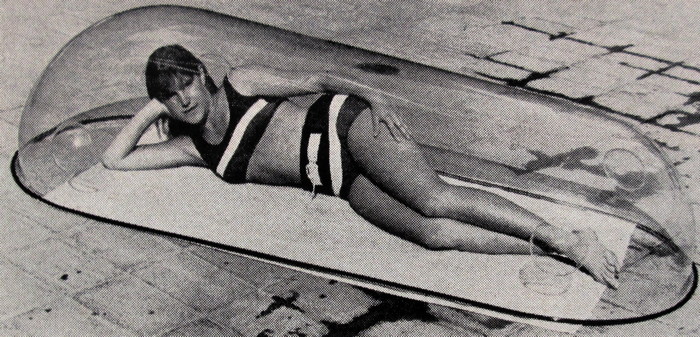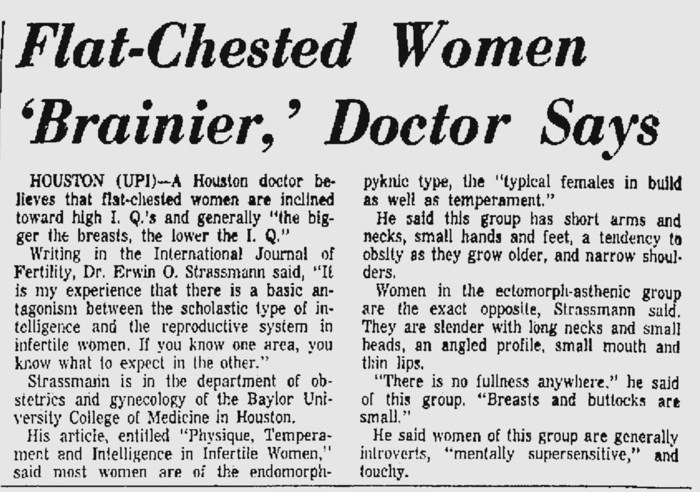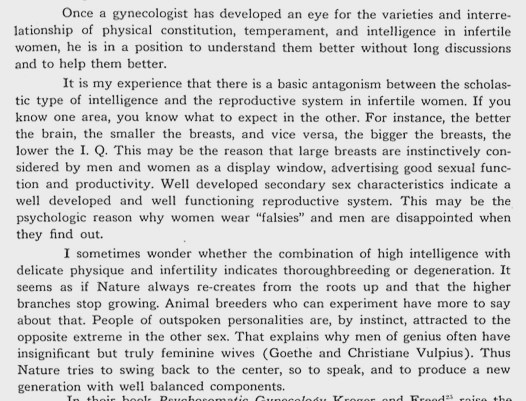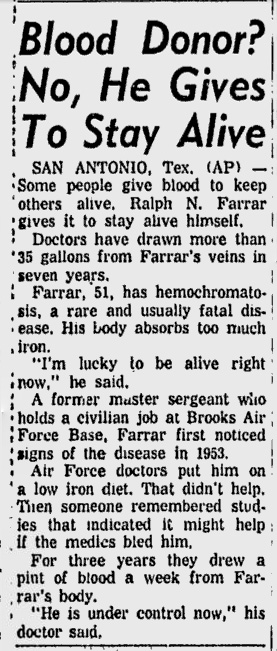1960s
Sunbathing Bubble
This looks like it would roast you to a nice golden brown.
Source: Newsweek - Sep 16, 1963.
Posted By: Alex - Fri Aug 28, 2015 -
Comments (7)
Category: Products, 1960s
Brains and Bust Size — one medical opinion
Back in 1964, Dr. Erwin O. Strassmann of Houston kicked up a controversy by suggesting there was a correlation in women between bust size and I.Q. And he managed to get his opinion published in a peer-reviewed journal.
Kingsport Times-News - Aug 30, 1964
Curious to see exactly what he said, I tracked down his article. Turns out he was an enthusiastic follower of the now-discredited theory of "constitutional psychology." This was an effort to establish a link between body type and personality traits. Critics have dismissed it as an extended exercise in dressing up cultural stereotypes (such as, if you're overweight, you're lazy) in scientific language. For devotees of weird science, the entire field is a goldmine of strangeness.
Here's the relevant section of Strassmann's 1964 article:


Strassmann, E.O. (1964). "Physique, Temperament, and Intelligence in Infertile Women." International Journal of Fertility. 9:297-314.
Posted By: Alex - Thu Aug 27, 2015 -
Comments (12)
Category: Body, Brain, Science, Psychology, 1960s
The Animation of Joop Geesink
We marvel at films like Rudolph the Red-nosed Reindeer, or Wallace and Gromit, in which, during a given scene, one or two puppets might be in motion. I can't fathom the amount of work that Joop Geesink went through to create his films.
Posted By: Paul - Thu Aug 27, 2015 -
Comments (2)
Category: Stop-motion Animation, 1950s, 1960s, Europe
Giant Hand From Sky Terrifies Motorists
Another entry in our occasional series of ads featuring giant people.
source: Newsweek - Aug 26, 1963
Posted By: Alex - Thu Aug 20, 2015 -
Comments (5)
Category: Giant People in Ads, 1960s
Humane Bullfighting

A member of Club Taurino practicing humane bullfighting without bulls in a park near Woldingham, Surrey. 1963. One member played the bull while the others improved their cape work.
Image source: Newsweek - Sep 2, 1963
Posted By: Alex - Mon Aug 17, 2015 -
Comments (5)
Category: Sports, 1960s
Cheerios Kid and Cheerios Sue
From the days when a commercial could hold an entire narrative arc in thirty or sixty seconds. Apparently the Kid and Sue were thrill-seekers who could not resist dangerous environments.
Posted By: Paul - Fri Aug 14, 2015 -
Comments (2)
Category: Anthropomorphism, Daredevils, Stuntpeople and Thrillseekers, Food, Advertising, 1960s
Follies of the Madmen #256
What a simpler world...
Posted By: Paul - Sat Aug 01, 2015 -
Comments (5)
Category: Business, Advertising, Products, Disguises, Impersonations, Mimics and Forgeries, Food, 1960s, Australia
Fertilized roses with his own blood
Ralph Farrar suffered from hemochromatosis, which meant that his blood accumulated too much iron. The treatment was to have a pint of blood taken from him every week. This blood couldn't be used for other patients. So Farrar used it on his roses as an "iron-rich fertilizer instead of the commercial rose food containing dried animal blood."After eight years of weekly blood-drainings his condition began to improve, so much so that he only had to have blood taken once every two months. No word on what happened to his roses as a result.
Info source: Newsweek - Sep 2, 1963

Ralph Farrar pouring blood on his roses

The Tuscaloosa News - Jun 29, 1963
Update: Curious about how long Mr. Farrar could have lived with hemochromatosis, I did a google search and found what I'm pretty sure is his grave. He died at the age of 76 in 1989.
Posted By: Alex - Sun Jul 26, 2015 -
Comments (5)
Category: 1960s
Bohemian Dancers
Posted By: Paul - Sun Jul 26, 2015 -
Comments (3)
Category: Avant Garde, Bohemians, Beatniks, Hippies and Slackers, 1960s, Dance, Europe

| Who We Are |
|---|
| Alex Boese Alex is the creator and curator of the Museum of Hoaxes. He's also the author of various weird, non-fiction, science-themed books such as Elephants on Acid and Psychedelic Apes. Paul Di Filippo Paul has been paid to put weird ideas into fictional form for over thirty years, in his career as a noted science fiction writer. He has recently begun blogging on many curious topics with three fellow writers at The Inferior 4+1. Contact Us |




